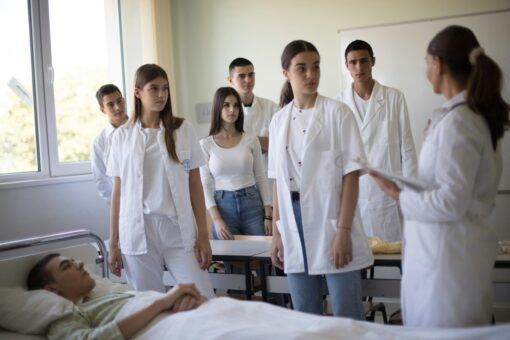
In the face of a deepening crisis in the NHS, the pressing challenge of doctor shortages is demanding urgent attention. Recent research published by the Sutton Trust, analysing data on almost 94,000 applicants to UK medical schools from 2012 to 2022, sheds new light on the structural issues that underlie this challenge. Despite a remarkable 64% surge in medical school applications over the past decade, the number of entrants has not grown in parallel – a disconnect that not only exacerbates workforce shortages but also deepens existing inequities in the medical profession.
The growing gap: rising applications, uneven success
The NHS is confronting a longstanding problem: a shortage of doctors that has been further magnified by an ageing workforce and escalating patient demand. With the NHS Long Term Workforce Plan targeting an expansion of medical school places to up to 15,000 per year by 2031/32, one might assume that the recruitment pipeline is set for transformation. However, the reality is more complex. If the current admissions processes continue to favour candidates from traditionally advantaged backgrounds, this expansion could result in a workforce that remains both numerically insufficient and unrepresentative of the diverse communities the NHS is meant to serve.
A diverse workforce is not just a matter of fairness – it is a strategic necessity. Doctors from varied socio-economic backgrounds bring unique insights and experiences that enhance patient care and foster trust within communities. In an era when health disparities are increasingly in focus, ensuring that the medical profession mirrors the society it serves is essential for building an NHS that is both effective and equitable.
One of the most striking findings from the report is the disparity in success rates among applicants from different educational backgrounds. The majority of schools and colleges that sent any applicants to medical school during the time frame did so in very small numbers – specifically, 80% of these institutions sent fewer than five applicants per year, with a single applicant being the most common number. (Note: This only includes institutions that sent at least one applicant – those that sent none are not represented in this sample.)
However, independent (fee-paying) schools maintained the highest offer and entrance rates, even after taking into account academic performance. This persistent gap suggests that many promising candidates – those who could provide vital support to an overstretched NHS – may be sidelined by systemic factors.
These factors could include inadequate preparation, limited access to guidance, and insufficient exposure to the rigours of competitive admissions. In effect, while applications have soared, the benefits of this increased interest in medicine are not being equitably distributed.
Contextualised admissions to balance socioeconomic disparities
The research further highlights that although the proportion of applicants from the lowest socio-economic groups has doubled over the past decade these candidates still represent only 5% of those admitted. The major barrier to this appears to be lower grades and how these are taken into account by medical schools. This underrepresentation is particularly concerning because evidence suggests that doctors from disadvantaged backgrounds are more likely to serve in underserved areas, directly addressing local healthcare shortages. Although contextual admissions are in effect across medical schools, the persistent underrepresentation shows that more work is needed.
The data also uncovers nuances in academic performance. Even among applicants with very high predicted A-level grades, those from the lowest socio-economic groups had University Clinical Aptitude Test (UCAT) scores that were, on average, about 5% lower (roughly half a standard deviation) than their peers from higher socio-economic backgrounds.
This is critical as UCAT scores are one of the main admission criteria used by medical schools. These figures point to deeper structural issues that traditional academic metrics may not fully capture the potential of candidates who face systemic disadvantages.
Actionable reforms: strengthening the medical pipeline
The findings of the Sutton Trust report make a compelling case for reforming medical school admissions and addressing the attainment gaps at school:
Enhanced support for disadvantaged candidates
One immediate step is to expand access to resources that prepare disadvantaged candidates for the rigours of medical school applications. It is likely that many promising candidates from non-selective state schools and further education colleges, which historically have some of the lowest entrant rates, require additional guidance. Mentorship programmes, preparatory courses, and targeted outreach initiatives can level the playing field.
Robust and transparent contextual admissions
Admissions processes could also be reformed to be more transparent about how each candidate’s background is considered, and the evidence this is based upon. Many medical schools consider contextual data during the admissions process. Contextual admissions – where an applicant’s background (such as their educational, socio-economic, and geographic context) is considered – has been a major step to ensuring that raw academic scores do not become the sole arbiter of success. However, the criteria and weighting remain largely opaque to applicants and the broader public. Greater transparency in how contextual factors are integrated into admissions decisions would not only build trust, make the process simpler for applicants, but also allow for the refinement of these processes through data-driven analytics.
Alternative entry routes
A promising approach to widening access to medical education could be increased uptake of gateway courses. Gateway courses are alternative entry pathways into medical school, designed specifically to widen access by offering lower academic entry requirements along with enhanced support – often through an extended foundation year – to underrepresented applicants. Evidence from the report shows that, when accounting for grades, applicants from the most deprived backgrounds who applied to at least one gateway course had significantly higher odds of receiving an offer compared to those who applied only to standard entry courses. Medical schools must also ensure that these students are appropriately supported throughout their studies to avoid potential difficulties.